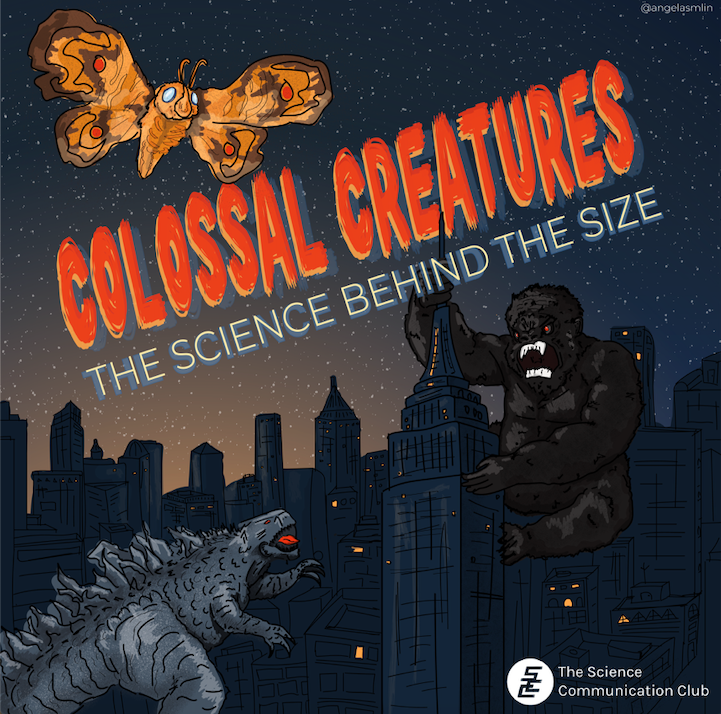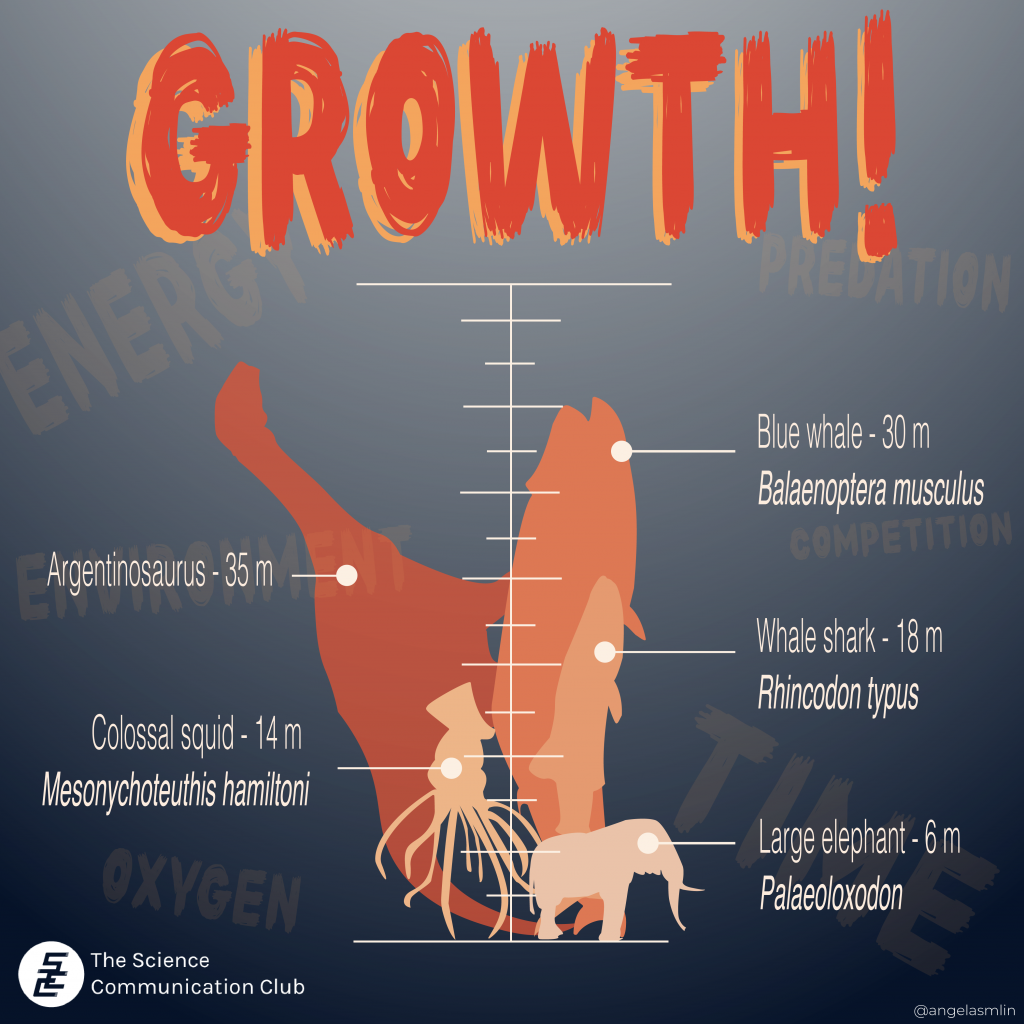
Written by Alejandro Izquierdo Lopez
Illustrated by Angela Lin
This article is part of our Special’s Week series, The Science of Science Fiction and Popular Media.
In the 1933 classic King Kong, a giant gorilla terrorizes New York City, towering above trucks and houses and standing menacingly atop the Empire State Building. Since then, the idea of animals larger than human-made structures has fascinated us. From the giant reptiloid Godzilla and insectoid Mothra to the fish-like Sea Kings in One Piece, colossal creatures are a recurring theme across media. These terrifying sizes may be fictional, but extremely large animals have inhabited and continue to inhabit Earth: the long-necked dinosaurs (the sauropods)1 and the blue whale (Balaenoptera musculus) are record-holders with lengths reaching more than 30 metres (100 feet)2!* But why are these animals so large? Could King Kong ever be real?
In the animal kingdom, a larger body size is usually better: it provides protection against predators and an advantage against peers, providing large individuals with more food and territory2. But growing requires two things: time and energy (in the form of oxygen and food), which are not always available. Many animals breathe or feed through their skin but at larger volumes they have proportionately less skin exposed. This is known as the “square-cube” law, and limits animals’ energy intake from surfaces as their size increases. The ribbon worm (nemertean) Lineus is a whale parasite that can reach up to 50 metres (180 feet) in length, but this is only thanks to its insignificant volume, with a width of less than 1 cm (0.4 inches). Similarly, insects breathe through a series of small canals known as trachea that cannot bring oxygen to the body at very large sizes. There was a time, though, around 300 million years ago, where oxygen concentrations were higher3, and dragonflies like Meganeura could reach up to 60 cm (23 inches).
Birds have the most efficient lungs in the animal kingdom and research suggests that lungs were probably similarly efficient in their ancestors: dinosaurs4. Sauropods like Argentinosaurus (35 metres in length, 115 feet) or Giraffatitan (23 metres, 75 feet) are the largest animals to have ever walked on land, but their high energetic demands probably required something else besides great lungs. Their long necks, for example, may have allowed them to obtain more food without the need to move their entire massive body4, thus reducing energy waste. The colossal squid Mesonychoteuthis hamiltoni (14 metres, 45 feet) follows a similar “gentle-giant” strategy, being more slow-paced than its more active but smaller cousins5. Food availability is also essential to reach a large size. Plankton, for example, is more abundant than large isolated prey. Both sharks and cetaceans were ancestrally fairly large predators, but only reached gigantic sizes after becoming plankton filter feeders6. The whale shark Rhincodon typus (18 metres, 59 feet), for example, is currently the largest cartilaginous fish, although still slightly smaller than the extinct megalodon Otodus megalodon (20 metres, 65 feet)7. Geography can also play a role in limiting size: islands, for example, provide fewer resources than the mainland. In that case, the opposite of supersized creatures happens: dwarf elephants measuring less than 2 metres in length used to live in the Mediterranean islands just before the origin of our species. If King Kong is real, then, he most certainly does not live on Skull Island.

Across its movies, Godzilla fights against many enemies of its size, showing a key evolutionary trigger for the origin of gigantism: predation and competition8. At larger sizes, animals can fend off predators and reduce competition, but as prey become bigger, so do their predators. Predatory dinosaurs like Giganotosaurus, which may have measured around 13 metres (42 feet), could be the result of an arms race to become increasingly larger against herbivorous dinosaurs like sauropods, reoccurring across multiple dinosaur lineages. Gigantic sizes, though, are only achievable in uncluttered open areas like the open ocean, savannahs or prairies2. Cenozoic giants like the rhinoceros’ ancestor Paraceratherium (7 metres, 22 feet) or Palaeoloxodon, one of the largest extinct elephants (6 metres, 19 feet) most likely inhabited these types of areas.
There is no straightforward explanation for why some animals become giants, but the need to fend off predators, coupled with good energy availability, seems to have been crucial. Is there a limit to size, though? Muscles and bones could theoretically withstand a maximum of 1000 tons with the right shape and size9, which is larger than any known land animal. This means that some of the first iterations of King Kong, which measure around 7 meters in height, may be in the realm of possibility, but Godzilla, usually around hundreds of metres, is not. To this extrapolation, though, we also need to assume that evolution found an optimal way for respiration, blood pumping, or muscles to work properly at those large sizes. In fact, the largest animals, whales, are almost at their maximum size; their feeding strategy is energetically very costly and they probably would not be able to sustain much larger sizes10. Unless the Sea Kings have found another system of filter-feeding, their size is also out of the realm of possibility.
While some individual animals can theoretically be slightly larger than our current record-holders, they may not be able to reach the sizes portrayed in popular media. If anything, giants must also face an additional tough obstacle, present throughout evolutionary history: extinction2. Environments change throughout the course of history and so does food availability — being larger is not the best solution in times of shortage or in changing environments. Many of the Cenozoic giant mammals such as mammoths or giant sloths, for example, went extinct after their habitat changed due to the arrival of humans and the end of the Ice Ages. In a time of global changes in our ecosystems, we better take care of our Godzillas.
*Size is always measured as body length for this article unless stated otherwise. Many of the sizes mentioned are mainly taken from Vermeij 2016, with some taken from the other following references. Sizes for dinosaur species may vary slightly across authors.
Sources
- Calvo JO, Juárez Valieri RD, Porfiri JD. Re-sizing giants: estimation of body lenght of Futalognkosaurus dukei and implications for giant titanosaurian sauropods. 3. Congreso Latinoamericano de Paleontología de Vertebrados. 2008;(January):43.
- Vermeij GJ. Gigantism and its implications for the history of life. PLoS ONE. 2016;11(1):1–22. doi:10.1371/journal.pone.0146092
- Harrison JF, Kaiser A, VandenBrooks JM. Atmospheric oxygen level and the evolution of insect body size. Proceedings of the Royal Society B: Biological Sciences. 2010;277(1690):1937–1946. doi:10.1098/rspb.2010.0001
- Sander PM, Christian A, Clauss M, Fechner R, Gee CT, Griebeler EM, Gunga HC, Hummel J, Mallison H, Perry SF, et al. Biology of the sauropod dinosaurs: the evolution of gigantism. Biological Reviews. 2011;86(1):117–155. doi:10.1111/j.1469-185X.2010.00137.x
- Rosa R, Seibel BA. Slow pace of life of the Antarctic colossal squid. Journal of the Marine Biological Association of the United Kingdom. 2010:1375–1378. doi:10.1017/S0025315409991494
- Pimiento C, Cantalapiedra JL, Shimada K, Field DJ, Smaers JB. Evolutionary pathways toward gigantism in sharks and rays. Evolution. 2019;73(3):588–599. doi:10.1111/evo.13680
- Perez VJ, Leder RM, Badaut T. Body length estimation of neogene macrophagous lamniform sharks (Carcharodon and Otodus) derived from associated fossil dentitions. Palaeontologia Electronica. 2021;24(1). doi:10.26879/1140
- Slater GJ, Goldbogen JA, Pyenson ND. Independent evolution of baleen whale gigantism linked to Plio-Pleistocene ocean dynamics. Proceedings of the Royal Society B: Biological Sciences. 2017;284(1855). doi:10.1098/rspb.2017.0546
- Hokkanen JEI. The size of the largest land animal. Journal of Theoretical Biology. 1986;118(4):491–499. doi:10.1016/S0022-5193(86)80167-9
- Potvin J, Goldbogen JA, Shadwick RE. Metabolic expenditures of lunge feeding rorquals across scale: implications for the evolution of filter feeding and the limits to maximum body size. PLoS ONE. 2012;7(9). doi:10.1371/journal.pone.0044854